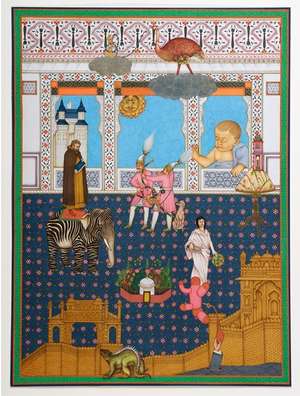
Luminously Between Eternities
Written by Waswo X Waswo, November 30, 2018
The irony of the severe traditionalist is their inability to perceive, or appreciate, the continuity of tradition as it mutates into the contemporary. As has been said many times before, “tradition” is not static: it reacts to geographies, power structures, pedagogical lineage, patronage, existential threats, praise, new histories, economics, and the pure joy of innovation and discovery. When we speak of the miniature tradition we already embrace a lexicon of transmission, transmutation, and distinctly evolved styles. These styles are most often expressed in geo-political terms. There is Persian, Moghul, Ottoman, and even Thai. There is Pahari, Bikaneri, Deccani, Oudh, Mewari and Marwari. And if we choose to break things down further, Bundi School, Devgarh, and Nagaur. Each of these geographically defined schools has of course morphed with time. Thus we speak of early Jodhpur as opposed to late Jodhpur; early Moghul as opposed to late Moghul. The point being, nothing within the miniature tradition ever remained constant, but rather, change was the norm.
What then defines a miniature painting? For the layman, the answer is often that of size, and in part, this assumption would be true. Such paintings were firstly painted as a means to illumine manuscripts and meant to be contained within folios only available to royalty. The delight of a miniature was its ability to be held within the hand and gazed at in close proximity while offering up to its owner the exquisite detail contained within. However, definition by size neglects not only the examples of large hunt and battle scenes that Maharajahs were prone to commission, but also the obvious importance of style: the graceful line of well-trained hands, the flattened picture plane, the construction of depth through layering rather than perspective, figures sized according to importance rather than reality, the intricacy of detail, the formal approach to portraiture, the idealization of landscape, the lushness of gardens, the primacy of the border, and the extraordinary subtly of colorations.
This exhibition will explore the trajectory of the aforementioned into contemporary times. Today, a wide variety of artists make reference to the miniature tradition from a diverse array of perspectives. Not all define themselves as “contemporary miniaturists”, but all give acknowledgment to the influence of miniature painting in their work. Proceeding from a framework that emphasizes visuality and technique as a means to express an artist’s social and individual concerns, this exhibition will not only be an attempted overview of the influence of miniature painting in contemporary art today, but also an attempt to connect dots between the historical and the now.


